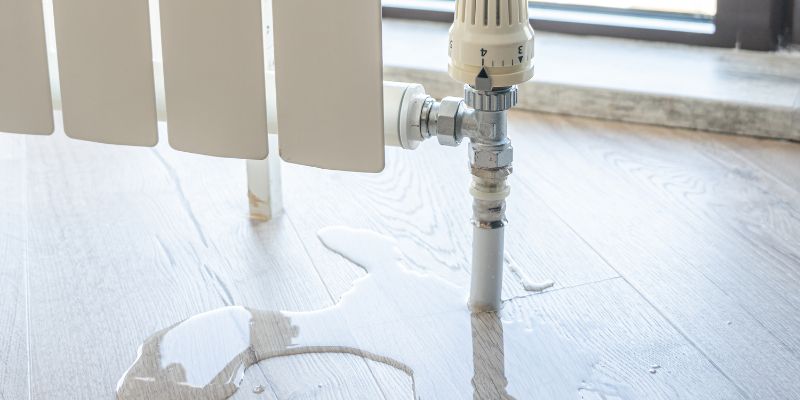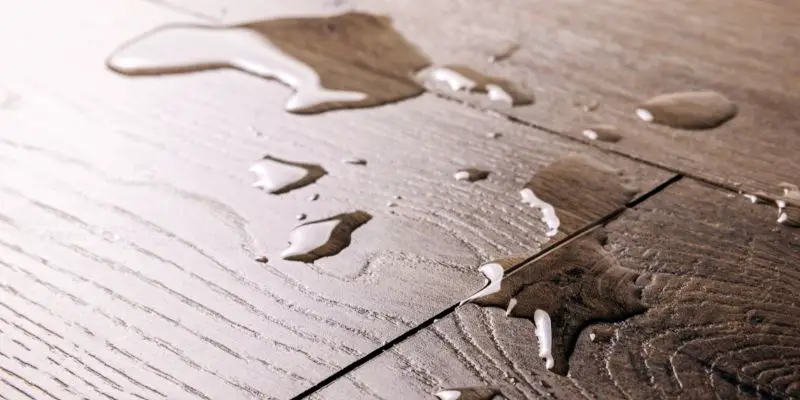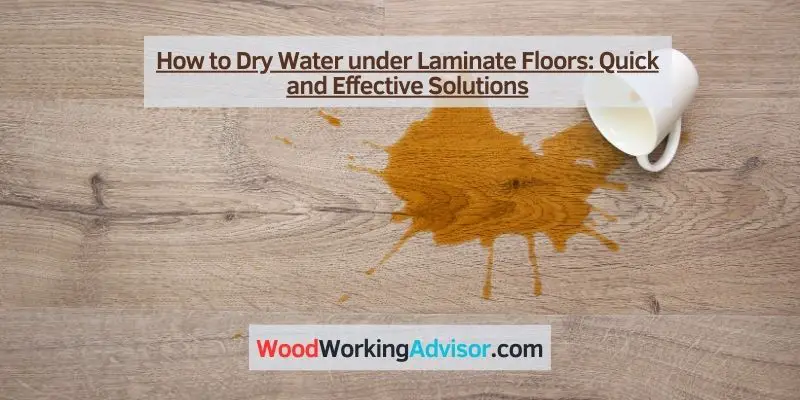To dry water under laminate floors, start by using a wet vacuum or towels to remove as much water as possible. Then, use fans or a dehumidifier to circulate air and expedite the drying process.
Water damage can be a nightmare for homeowners, especially when it seeps beneath your beautiful laminate floors. Whether it’s a spill, a plumbing leak, or a flood, the excess water must be promptly dried to prevent further damage and the growth of mold and mildew.
However, tackling this issue requires a systematic approach to ensure the job gets done effectively. We will explore the steps you can take to dry water under laminate floors, allowing you to restore your flooring to its former glory and maintain a safe and healthy home environment.
Understanding The Causes Of Water Under Laminate Floors
Water damage under laminate floors can be a real headache for homeowners. Not only can it lead to costly repairs, but it can also pose health risks if left untreated. Understanding the causes of water under laminate floors is crucial in order to prevent further damage and take necessary remedial measures. In this section, we will explore the common causes of water damage and the potential risks and damage it can cause.
Common Causes Of Water Damage
- Plumbing leaks: One of the most common causes of water under laminate floors is plumbing leaks. Whether it’s a burst pipe, a leaking faucet, or a faulty water supply line, plumbing issues can result in significant water damage if not addressed promptly.
- Floods: Natural disasters like floods can cause extensive water damage, and laminate floors are not immune to their effects. Whether it’s due to heavy rainfall, overflowing rivers, or a broken dam, floods can seep into your home and result in water under your laminate floors.
- Moisture accumulation: Excessive moisture in the air can also lead to water under laminate floors. Poor ventilation, high humidity levels, or condensation buildup can create a damp environment that gradually seeps into the flooring material.
- Improper installation: Improper installation of laminate flooring can contribute to water damage. Gaps between the seams or inadequate subfloor sealing can allow water to penetrate and accumulate beneath the surface.

Potential Risks And Damage
Water under laminate floors can lead to a host of problems, both immediate and long-term. Some potential risks and damage include:
- Mold and mildew growth: The presence of water creates the perfect breeding ground for mold and mildew. These fungi not only cause unsightly stains and odor but can also pose health risks, especially for individuals with respiratory problems or allergies.
- Structural damage: Prolonged exposure to water can weaken the subfloor and supporting structures, potentially compromising the structural integrity of your home. This can result in costly repairs or even the need for a complete floor replacement.
- Warped and damaged laminate flooring: Laminate floors are not designed to withstand prolonged exposure to water. As a result, the laminate boards can warp, swell, or become discolored when water seeps into them. This can lead to unsightly and uneven flooring that may need to be replaced.
- Decreased property value: Water damage can significantly reduce the value of your property. If left unresolved, the presence of water under laminate floors can deter potential buyers and make it challenging to sell your home in the future.
Now that we understand the causes and potential risks of water under laminate floors, it’s crucial to take immediate action if you notice any signs of water damage. In the next section, we will explore the steps you can take to effectively dry water under laminate floors and minimize the associated risks.
Quick Solutions To Dry Water Under Laminate Floors
Looking to dry water under your laminate floors? Here are quick and effective solutions to tackle this common problem. Ensure a dry and safe environment with these simple steps.
When water finds its way under your laminate floors, it can quickly become a major headache. The good news is that there are quick and effective solutions to help you dry the water and prevent further damage to your floors. In this section, we will explore the steps you can take to assess the severity of the situation, remove surface water, use moisture absorbing materials, utilize fans and dehumidifiers, and lift and dry the affected laminate.
Assessing The Severity Of The Situation
The first step in drying water under laminate floors is to assess the severity of the situation. This will help you determine the extent of the damage and the appropriate measures to take. Start by checking the affected areas for signs of swelling, discoloration, or a musty odor. If the water has been sitting for a long time, it may have seeped deeper into the flooring, requiring more extensive drying methods.
Removing Surface Water
Once you have assessed the severity of the situation, it is important to remove any surface water as quickly as possible. Use towels or a wet-dry vacuum to soak up the excess moisture. Be sure to wring out the towels or empty the vacuum regularly to prevent spreading the water to other areas of the floor.
Using Moisture Absorbing Materials
After removing the surface water, it is crucial to continue the drying process by using moisture absorbing materials. Place desiccants such as silica gel or cat litter in breathable bags or containers and distribute them evenly across the affected areas. These materials will help absorb the remaining moisture and prevent further damage to your laminate floors.
Utilizing Fans And Dehumidifiers
To expedite the drying process, you can utilize fans and dehumidifiers. Position fans in the affected areas to increase air circulation and promote evaporation. A dehumidifier can also be used to remove excess moisture from the air. Keep the affected areas well-ventilated by opening windows and doors, if possible, to allow for better airflow.
Lifting And Drying The Affected Laminate
In more severe cases where the water has penetrated the laminate, lifting and drying the affected pieces may be necessary. Start by lifting the edges of the laminate with a putty knife or a similar tool. This will allow air to circulate underneath and facilitate the drying process. Use towels or fans to encourage drying, and monitor the affected areas closely to ensure they are thoroughly dry before re-installing or replacing the laminate.
In conclusion, drying water under laminate floors requires prompt action to prevent further damage. Assessing the severity of the situation, removing surface water, using moisture absorbing materials, utilizing fans and dehumidifiers, and lifting and drying the affected laminate are all quick solutions that can help restore your floors to their former glory. By following these steps, you can effectively dry water under laminate floors and minimize potential long-term issues.

Preventive Measures And Long-term Solutions
When it comes to water damage under laminate floors, taking preventive measures and implementing long-term solutions is essential. By addressing the underlying issue, improving ventilation, using waterproofing techniques, and implementing regular maintenance and inspections, you can effectively dry the water and prevent further damage.
Addressing The Underlying Issue
Addressing the underlying issue is crucial in preventing future water damage. Start by identifying the source of the water and ensuring it is fixed properly. This could be a leaky pipe, cracked foundation, or faulty plumbing. Once the source is identified, take immediate action to resolve it. Repair any damaged pipes, seal any gaps or cracks, or contact a professional plumber for assistance.
Improving Ventilation
Adequate ventilation plays a significant role in drying water under laminate floors. Poor ventilation traps moisture and contributes to the growth of mold and mildew. To improve ventilation, consider the following:
- Open windows and doors to allow fresh air circulation.
- Install exhaust fans in high moisture areas, such as the bathroom or kitchen.
- Use dehumidifiers to remove excess moisture from the air.
By improving ventilation, you create an environment that promotes drying and prevents the accumulation of moisture.
Using Waterproofing Techniques
Using waterproofing techniques is an effective method to prevent water damage under laminate floors. These techniques create a barrier between the laminate flooring and any potential moisture. Consider the following options:
| Waterproofing Technique | Description |
|---|---|
| Applying waterproof sealant | Apply a waterproof sealant over the subfloor before installing the laminate flooring. This provides an extra layer of protection against moisture. |
| Using moisture-resistant underlayment | Choose a moisture-resistant underlayment specifically designed for laminate flooring. This underlayment prevents moisture from seeping into the laminate material. |
| Utilizing waterproofing membranes | Install waterproofing membranes beneath the laminate flooring to create an impermeable barrier. These membranes effectively block any potential water or moisture. |
By using these waterproofing techniques, you can minimize the risk of water damage and keep your laminate floors dry.
Regular Maintenance And Inspection
Regular maintenance and inspection are crucial to ensure the longevity and durability of your laminate floors. Follow these maintenance tips:
- Clean spills and excess water immediately. Use a dry cloth or mop to soak up the moisture and prevent it from seeping into the flooring.
- Avoid excessive water usage during cleaning. Instead, use a damp mop or a cleaning solution specifically formulated for laminate floors.
- Inspect your floors regularly for any signs of water damage. Look for discoloration, warping, or bulging in the laminate material.
- Check the surrounding areas for any signs of water accumulation, such as damp walls or ceilings.
Regular maintenance and inspections help you catch any potential issues early on and take appropriate action to prevent further damage.
By addressing the underlying issue, improving ventilation, using waterproofing techniques, and implementing regular maintenance and inspections, you can effectively dry water under laminate floors and protect your flooring investment. Remember to take immediate action when water damage is detected, as prompt intervention can minimize the extent of the damage and prevent costly repairs.
Conclusion
To conclude, addressing water under laminate floors promptly is crucial to prevent further damage and ensure the longevity of your flooring. By following the steps outlined you can effectively dry the water and minimize any potential mold or mildew growth.
Remember to act swiftly, use appropriate tools, and consider seeking professional help for severe cases. Taking proactive measures will help you maintain a safe and pristine living environment.



4 thoughts on “How to Dry Water under Laminate Floors: Quick and Effective Solutions”